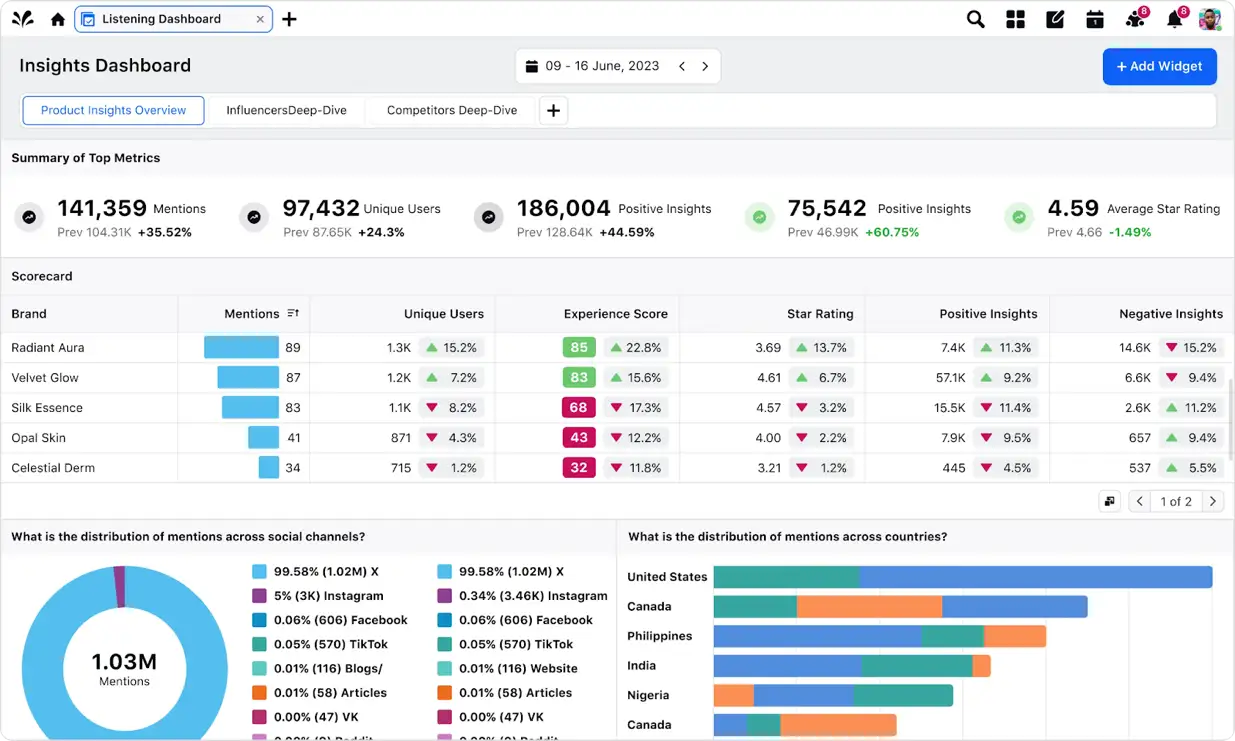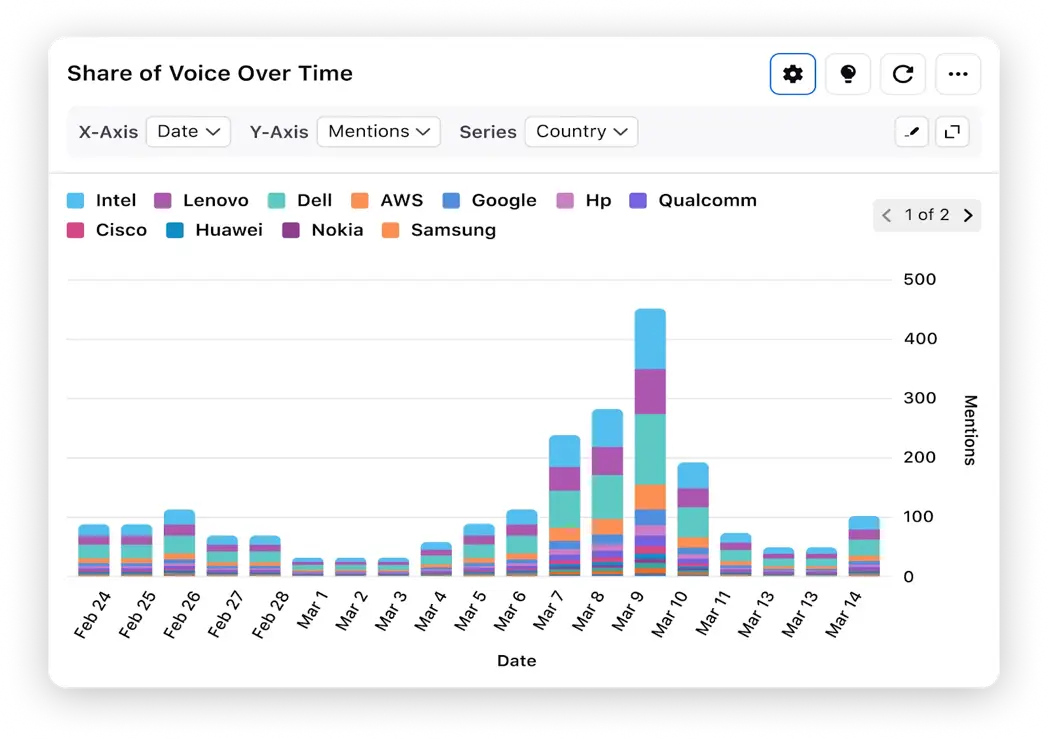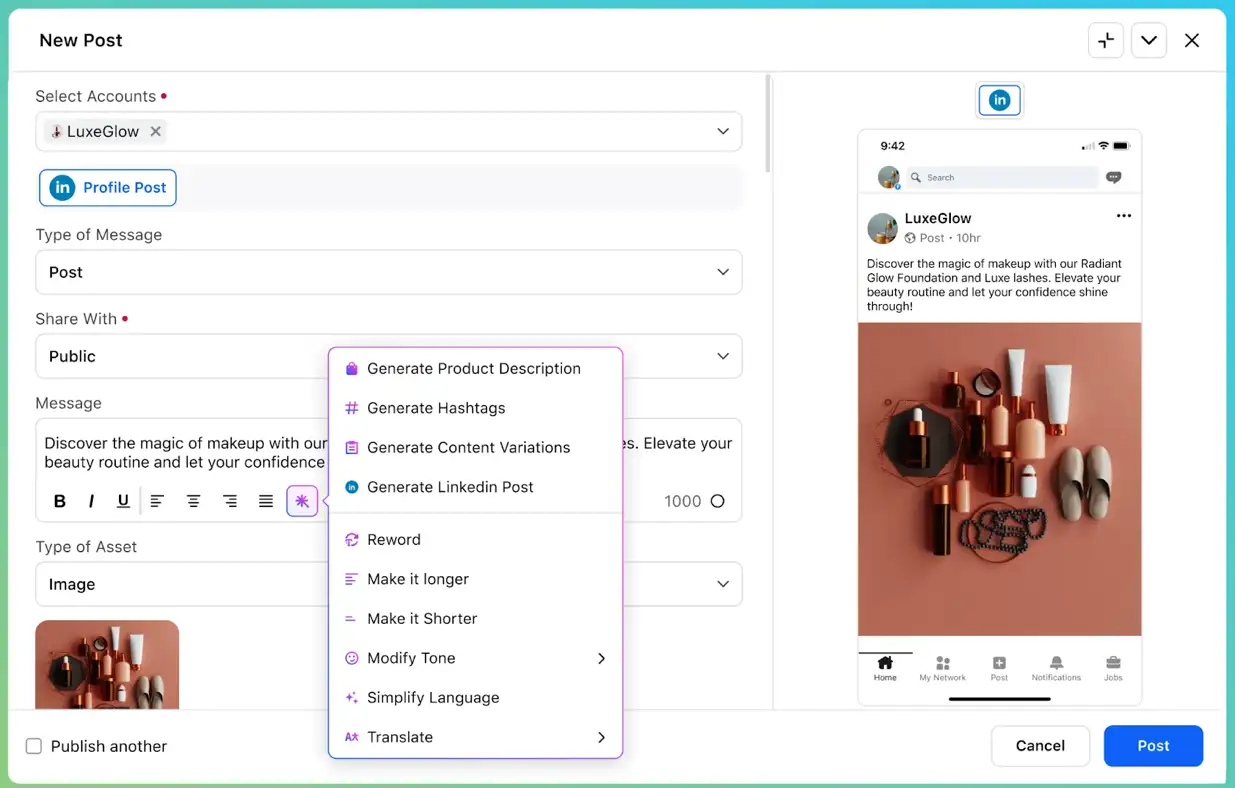The undisputed leader in social media management
For over a decade, the world’s largest enterprises have trusted Sprinklr Social for its in-depth listening, unmatched channel coverage, enterprise-grade configurability and industry-defining AI.

How to do Instagram Competitors Analysis in 5 Steps
What started as a platform for sharing personal moments has now transformed into a powerful business tool of the digital age. In 2024, Instagram competitor analysis has become essential for brands looking to outpace rivals and connect with their audiences meaningfully.
Instagram boasts over 2 billion active users, with 90% of them following at least one brand. This means brands are not just competing for attention; they’re competing for the trust and loyalty of their audience. Therefore, in addition to understanding your brand's performance, it is critical to evaluate what works for your competitors, identify successful social media tactics, discover untapped opportunities, and refine your approach to Instagram marketing.
For example, several celebrity cosmetic brands are highly active on Instagram, focusing on competitor analysis, building communities, and leveraging influencer marketing to promote their brand. They are also expanding their product ranges to be more inclusive of different skin tones. Let's explore how to conduct a thorough Instagram competitor analysis to elevate your brand's presence and outshine the competition.
- What does competitive analysis on Instagram mean?
- Instagram competitive analysis for B2B vs. B2C Brands
- Why is it important to perform Instagram competitive analysis?
- Key metrics involved in Instagram competitive analysis
- How to perform Instagram competitive analysis
- Top tools for Instagram competitive analysis
- Build your brand with Instagram competitive analysis
What does competitive analysis on Instagram mean?
Competitive analysis on Instagram involves assessing and comparing your brand's performance with competitors by looking at social media metrics such as the type of content they share, publishing and engagement patterns, important KPIs, etc.
You can conduct Competitive analysis to:
· Learn from the success of your competitors and apply those insights to drive your strategy.
· Set benchmarks based on data-driven insights to refine your content strategy continuously.
· Assess the competitive landscape to identify the threats posed by your competitors.
· Identify emerging trends and shifts in audience preferences.
Various competitor analysis tools help you assess your competitors, identify your market position and provide you with relevant metrics.
Instagram competitive analysis for B2B vs. B2C Brands
Although both B2B and B2C marketing aim to drive relevant leads, build and strengthen customers' trust and position organizations (and organizational leaders) as thought leaders within their niche. It's crucial to understand that conducting an Instagram competitor analysis for B2B and B2C brands requires a focus on different factors and metrics.
Metrics | B2C brands | B2B brands |
Content focus | Emotionally engaging and visually appealing content | Professional relationships, industry expertise and thought leadership |
Audience engagement | Prioritizing mass appeal, analyzing competitors, understanding viral trends and driving engagement | Targeting specific audiences like decision-makers, focusing on competitors' strategies |
Marketing Goals | Consumer awareness, brand loyalty and immediate sales | Building credibility, long-term relationships and lead generation |
Using Instagram features | Focus on visually appealing reels and stories | Leverage carousel posts for detailed content |
Must read: How to develop a B2B social media strategy in 4 easy steps
Why is it important to perform Instagram competitive analysis?
Conducting competitor analysis on Instagram helps you stay relevant, gain a competitive edge, refine your strategy, and outshine your competitors. The insights you gain drive smarter decisions, keeping you ahead of the game. Here are some other key advantages of it:
- Competitive benchmarking: It lets companies assess performance by comparing predetermined metrics with competitors. By analyzing key metrics like follower count, engagement rates and content performance, you can establish KPIs that measure your success relative to industry standards and competitors.
Pro Tip 💡: To effectively navigate the competitive landscape on Instagram, brands must leverage sophisticated tools that provide insights into their performance relative to competitors. With the rapid expansion of marketing channels, competition is often fierce and fast-paced.
How can you efficiently compare your social performance against your competitors and track their social media content strategies?
The answer is simple — try Sprinklr’s Competitive Benchmarking Dashboard. It allows you to:
- Access 10+ pre-built dashboards
- Discover and compare content themes, customer sentiments, audience behaviors, and more.
- Automatically generate and share reports with various teams. Set up alerts to be notified of spikes or drops in key metrics.

- Competitor monitoring for social media engagement: Social media is used by over 75% of the eligible global population currently and is often the first indicator of new developments, whether a product feature, pricing change or leadership shift. So, even if you're not actively engaging, staying observant is essential to staying ahead of the curve.
- Market trend adaptation: Through social media competitive analysis, your business can effectively adapt to market trends, ensuring long-term success and resilience in an ever-evolving marketplace.
Monitoring competitors' adoption of new features like Reels and Guides, as well as their response to algorithm updates, can help your approach stay relevant and engage your audience.
Key metrics involved in Instagram competitive analysis
While conducting Instagram competitive analysis, it is crucial to focus on key metrics to get detailed insight into your competitors’ performance. Let’s look at some important metrics and how to measure them:
1. Follower growth rate
What it means: This metric helps you track the pace at which a competitor's Instagram following increases over time.
Key use: Helps identify how well a competitor is attracting new followers and expanding their reach over time.
How to track competitors’ follower growth rate?
· Track your competitor's follower count at regular intervals to monitor growth trends.
· Calculate the percentage increase or decrease in followers over time.
· Compare their growth rate to your own and industry benchmarks.
· Identify spikes in their follower growth during key content releases or campaigns.
2. Instagram engagement per follower
What it means: This metric helps you measure how actively a competitor's followers interact with their content (likes, comments, shares).
Here’s the formula to calculate the Instagram engagement rate:
Key use: Offers insight into how effectively a competitor’s content resonates with their audience, indicating content quality and relevance.
How to track competitors’ engagement rate per follower:
· Analyze the total number of likes, comments and shares per post from your competitors.
· Divide their total engagement by their follower count to gauge engagement per follower.
· Calculate the average engagement rate across their posts over a given time frame.
· Compare their engagement rates to identify which types of content perform best.
Related Read: How to measure social media engagement effectively
3. Impressions
What it means: This metric shows how often a competitor's posts are viewed, reflecting overall visibility.
Use this formula to calculate the engagement rate by impressions:
Key use: Shows how visible a competitor's posts are, helping gauge their content's exposure and reach.
How to measure competitors’ impressions:
· Use analytics tools to track how often your competitor’s posts are viewed.
· Monitor their impressions per post or campaign to assess their content’s reach.
· Observe changes in impressions after they publish new content or run social ads.
· Compare their impression trends with your own to evaluate overall visibility.
4. Reel Metrics
What it means: Analyzes engagement, views and reach of a competitor's Instagram Reels to assess content performance.
Key use: Assesses the popularity and engagement of a competitor’s Reels, allowing you to understand what content formats work best.
How to track competitors’ reel metrics?
· Track the number of views, likes, comments and shares on your competitor’s Reels.
· Analyze their Reel reach to understand how many unique viewers they are attracting.
· Monitor completion rates to see how well their Reels retain viewer attention.
· Compare the performance of their Reels to other content formats they use.
Looking glass: Social analytics common metrics and dimensions
5. Stories Metrics
What it means: Evaluate the effectiveness of a competitor’s Instagram Stories through metrics like views, taps and completion rates.
Key use: Provides insights into how engaging and effective a competitor’s Stories are, indicating how well they retain viewer attention.
How to track competitors’ stories metrics:
· Analyze your competitor’s Story views, replies and sticker interactions.
· Monitor completion rates to see how many viewers watch their Stories till the end.
· Track viewer behavior, including taps forward, backward and Story exits.
· Compare how their Stories perform relative to your own and other competitors.
6. Profile Interactions
What it means: This metric helps you track activities on a competitor's profile (clicks, follows, DMs) to gauge audience interest.
Key use: Provides insights into how engaging and effective a competitor’s Stories are, indicating how well they retain viewer attention.
🔎 How to track competitors’ profile interactions:
· Monitor the number of profile visits, website clicks, and contact actions competitors receive.
· Track follower growth from profile interactions to see how engaging their bio and profile are.
· Identify spikes in profile activity following content releases or promotions.
· Compare their profile interaction trends to see how well they convert views into actions.
7. Audience sentiments
What it means: Refers to the emotional tone — positive, negative, or neutral — expressed by users in their comments, likes and interactions with a brand’s content.
Key use: Understanding customer sentiment is crucial for brands to gauge public perception, manage reputation and inform marketing strategies.
How to track competitors’ audience sentiments:
· Monitor comments, context and frequency of competitor mentions in other users' stories and posts.
· Classify sentiments into positive, negative and neutral feedback. Try to find what is driving negative reviews.
· Automate sentiment analysis via mentions and comments using specialized tools such as Sprinklr.
How to perform Instagram competitive analysis
Here’s a step-by-step guide to conducting an effective Instagram competitive analysis:
Step 1: Identify your competitors
Begin your Instagram competitor analysis by identifying both direct and indirect competitors. Include both small and large brands in your industry to get a full view of the competitive landscape. Don’t forget to follow industry leaders—these accounts are a valuable source for trends, product launches, and innovative strategies.
For example, if you're in the beauty industry, follow major accounts like Allure, Sephora, or Huda Beauty to stay on top of the latest trends and see how these brands engage their audience.
Step 2: Collect relevant data
Now that you've identified your competitors, it's time to gather critical data on their Instagram activity. Focus on key metrics like hashtags, engagement, content types, and follower behavior. Use competitor analysis tools to:
· Track their posting frequency and content format (carousels, videos, static images).
· Calculate engagement rates by dividing total engagement actions by impressions. Don’t forget to check the total number of interactions on each post.
· Analyze their hashtag strategy: What hashtags are they using? How many hashtags appear in each post?
Use a standardized template to keep your data consistent and ensure you’re focusing on the metrics that matter most to your business.
Pro Tip 💡: Best way to choose your hashtags
Hashtags boost visibility, connect with relevant audiences and highlight trends. Use AI, broad channel coverage and deep listening to analyze competitors and optimize your content strategy.
Want to master hashtags? Read 👉How To Use Hashtags for expert tips, mistakes to avoid proven ways to make the most of trending hashtags!
Step 3: Create a report
Once you are done collecting the data, it's time to get started with reporting. To draw better conclusions, create dashboards and reports. Identify trends and patterns in their strategy; analyze their strengths and weaknesses and compare them with yours.
Ensure that your reports are easy to understand and promptly shared with the team for strategic alignment.
Pro Tip 💡: Creating reports in the Instagram competitive analysis is crucial for tracking key metrics, identifying trends and benchmarking performance. Manually tracking every metric can be time-consuming!
So, what’s the solution?
The answer is simple — try Sprinklr’s Media Monitoring and Analytics Platform. It will help you to:
- Monitor competitor's brand mentions
- Build an effective PR strategy
- Discover trends and relevant metrics
Compare and measure your performance against competitors using Sprinklr Insights.

Intrigued? Request your demo today!
Step 4: Analyze Your Data
Analyzing data is essential for refining your Instagram strategy. It helps you understand how competitors engage their audiences and which content performs best. Ask yourself these key questions:
· Which hashtags drive the most engagement in your niche?
· What types of content (videos, carousels, images) perform best?
· Are there trends or opportunities you're missing?
· How does your Instagram performance compare to your competitors'?
If you notice a spike in a competitor’s engagement, investigate what triggered it. Are they using user-generated content or launching interactive campaigns to boost audience interaction?
Related read: How to leverage user-generated content to drive engagement
Step 5: Monitor engagement
Track engagement rates for each competitor and adjust your social media content strategy to capitalize on trends. Update your competitive analysis regularly to reflect the shifts in platform algorithms, audience behavior, and market trends.
Pro Tip 💡: Monitoring engagement is important to get detailed insights into your audience's behavior. But is it really possible to track every like, comment or share manually? How can you simplify the process?
By using Sprinklr’s Social Publishing & Engagement dashboard, you can:
- Monitor online reviews and social media content
- Maintain your brand’s visibility and signature
- Track key metrics and influencers to streamline your content strategy
So, join the list of enterprises that are using Sprinklr Social and experience the best by yourself.

Top tools for Instagram competitive analysis
To dominate your niche on Instagram, you need to go beyond just posting great content. Here are the tools that can help you analyze your competitors on Instagram:
Sprinklr
Sprinklr offers one of the most powerful and comprehensive platforms for social media management and competitor analysis. As an all-in-one solution, here’s how Sprinklr helps you stay ahead of the competition:
1. Sprinklr Social
Sprinklr Social integrates various applications for social media marketing, advertising, content management and customer care. Its Instagram competitor analysis tools leverage AI-driven insights to provide a comprehensive view of competitors across social platforms.
· Sprinklr Social promises broad channel coverage, tracking customer interactions across 30+ digital channels with the flexibility to add new ones in just weeks.
· ️Automate your social media management with advanced Sprinklr AI, enabling quick content creation with the best AI capabilities.
· Maintain consistent, on-brand interactions by implementing custom approval workflows, governance policies and moderation procedures for all engagements.
· Elevate your social media management by unifying consumer insights and marketing customer service into one seamless platform.
2. Competitive Benchmarking Tool
3. Social Listening Tool
Sprinklr’s Social Listening tool enables brands to monitor conversations about their competitors in real time. It is a crucial part of market research, offering real-time access to your audience's pulse and enabling you to make informed decisions.
BuzzSumo
BuzzSumo is perfect for discovering which content is performing best for your competitors. With its easy-to-use interface, you can quickly identify trending topics, popular posts, and the strategies that drive engagement. It allows you to analyze the types of content getting the most engagement from your competitors. BuzzSumo helps you identify the most effective content strategies by tracking metrics such as shares, comments, and likes. This allows you to fine-tune your content to better resonate with your audience.
Brandwatch
Brandwatch is a social media listening and analytics tool that excels at competitor analysis. With its advanced AI capabilities, Brandwatch can analyze sentiment around your competitors' Instagram posts, track trending topics, and monitor competitor campaigns. You can also understand how competitors' audiences interact with their content, providing valuable insights for your strategy.
Hootsuite
Hootsuite offers a streamlined platform to monitor competitors’ Instagram accounts, analyze engagement rates, and track trends. It also lets you schedule and manage content, making it easy to stay on top of your Instagram game while keeping an eye on competitors.
Build your brand with Instagram competitive analysis
Instagram's competitive analysis is essential for staying relevant in today’s cutthroat business environment. Using advanced strategies and tools, businesses can gain valuable insights into competitor performance, content trends and audience engagement patterns. This analysis reveals what works and what doesn’t, allowing for data-driven adjustments.
Tools like Sprinklr Social are invaluable when conducting a successful competitor analysis. Their comprehensive data and features help you track competitors’ strategies and uncover insights.
Ready to level up your Instagram strategy? Book a demo with Sprinklr Social today!
Frequently Asked Questions
You can conduct monthly analyses to stay updated with the current business trends and in-depth quarterly analyses to get insights into social media performance.
Tools like Sprinklr Insights can help analyze Instagram stories and reels effectively and get actionable insights.
AI automates the data collection process and provides real-time insights on competitor performance and trends.
Businesses can use competitive analysis to improve their ad formats, messaging and targeting of their ads.
While conducting Instagram competitive analysis, businesses must avoid unauthorized data access, respect privacy and comply with data protection laws and platform policies.


